The Integumentary System - Ailments: what can go wrong with the integumentary system
Unlike some other body systems, the integumentary system quickly shows when it is afflicted by an aliment or malady. Over one thousand different aliments can affect the skin. The most common skin disorders are those caused by allergies or bacterial or fungal infections. Burns and skin cancers, although less common, are more dangerous. In some cases, they can be lethal.
Acne (AK-nee): Disorder in which hair follicles of the skin become clogged and infected.
Athlete's foot: Common fungus infection in which the skin between the toes becomes itchy and sore, cracking and peeling away.
Basal cell carcinoma (BAY-sal CELL car-si-NO-ma): Skin cancer that affects the basal cells in the epidermis.
Carcinoma (car-si-NO-ma): Cancerous tumor of the skin, mucous membrane, or similar tissue of the body.
Dermatitis (der-ma-TIE-tis): Any inflammation of the skin.
Malignant melanoma (ma-LIG-nant mel-ah-NO-ma): Cancer of melanocytes; the most serious type of skin cancer.
Psoriasis (so-RYE-ah-sis): Chronic skin disease characterized by reddened lesions covered with dry, silvery scales.
Seborrheic dermatitis (seh-beh-REE-ik der-ma-TIE-tis): Commonly called seborrhea, a disease of the skin characterized by scaly lesions usually on the scalp, hairline, and face.
Squamous cell carcinoma (SKWA-mus CELL carsi-NO-ma): Skin cancer affecting the cells of the second deepest layer of the epidermis.
Vitiligo (vit-i-LIE-go): Skin disorder in which the loss of melanocytes results in patches of smooth, milky white skin.
Warts: Small growths caused by a viral infection of the skin or mucous membrane.
The following are just a few of the many ailments that can target the integumentary system.
Acne
Acne is a skin disease marked by pimples on the face, chest, and back. The most common skin disease, acne affects an estimated 17 to 28 million people in the United States. Although it can strike people at any age, acne usually begins at puberty and worsens during adolescence.
At puberty, increased levels of androgens (male hormones) cause the sebaceous glands to secrete an excessive amount of sebum into hair follicles. The excess sebum combines with dead, sticky skin cells to form a hard plug that blocks the follicle. Bacteria that normally lives on the skin then invades the blocked follicle. Weakened, the follicle bursts open, releasing the sebum, bacteria, skin cells, and white blood cells into the surrounding tissues. A pimple then forms.
Treatment for acne depends on whether the condition is mild, moderate, or severe. The goal is to reduce sebum production, remove dead skin cells, and kill skin bacteria. In very mild cases, keeping the skin clean by washing with a mild soap is recommended. In other cases, medications applied directly to the skin or taken orally may be prescribed in combination with gentle cleansing.
Athlete's foot
Athlete's foot is a common fungus infection in which the skin between the toes becomes itchy and sore, cracking and peeling away. Properly known as tinea pedis, the infection received its common name because the infectioncausing fungi grow well in warm, damp areas such as in and around swimming pools, showers, and locker rooms (areas commonly used by athletes).
The fungi that cause athlete's foot are unusual in that they live exclusively on dead body tissue (hair, the outer layer of skin, and nails). Researchers do not know exactly why some people develop the condition and others do not. It is known that sweaty feet, tight shoes, and the failure to dry feet well after swimming or bathing all contribute to the growth of the fungus.
Symptoms of athlete's foot include itchy, sore skin on the toes, with scaling, cracking, inflammation, and blisters. If the blisters break, raw patches of tissue may be exposed. If the infection spreads, itching and burning may increase.
Athlete's foot usually responds well to treatment. Simple cases are treated with antifungal creams or sprays. In more severe cases, an oral antifungal medication may be prescribed.
Burns
There are few threats more serious to the skin than burns. Burns are injuries to tissues caused by intense heat, electricity, UV radiation (sunburn), or certain chemicals (such as acids). When skin is burned and cells
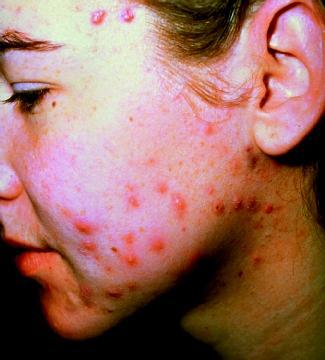
are destroyed, the body readily loses its precious supply of fluids. Dehydration can follow, leading to a shutdown of the kidneys, a life-threatening condition. Infection of the dead tissue by bacteria and viruses occurs one to two days after skin has been burned. Infection is the leading cause of death in burn victims.
Burns are classified according to their severity or depth: first-, second-, or third-degree burns.
First-degree burns occur when only the epidermis is damaged. The burned area is painful, the outer skin is reddened, and slight swelling may be present. Sunburns are usually first-degree burns. Although they may cause discomfort, these minor burns are usually not serious and heal within a few days.
Second-degree burns occur when the epidermis and the upper region of the dermis are damaged. The burned area is red, painful, and may have a wet, shiny appearance because of exposed tissue. Blisters may form. These moderate burns take longer to heal. If the blisters are not broken and care is taken to prevent infection, the burned skin may regenerate or regrow without permanent scars.
Third-degree burns occur when the entire depth of skin is destroyed. Because nerve endings have been destroyed, the burned area has no sensitivity. The area may be blackened or gray-white in color. Muscle tissue and bone underneath may be damaged. In these serious to critical burns, regeneration of the skin is not possible. Skin grafting—taking a piece of skin from an unburned portion of the burn victim's body and transplanting it to the
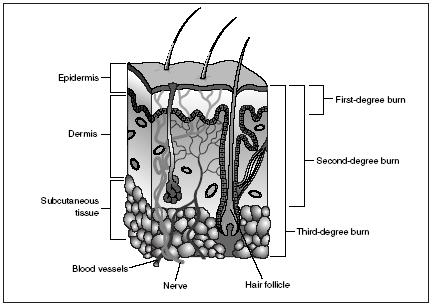
burned area—must be done to cover the exposed tissues. Third-degree burns take weeks to heal and will leave permanent scarring.
Dermatitis
Dermatitis is any inflammation of the skin. There are many types of dermatitis and most are characterized by a pink or red rash that itches. Two common types are contact dermatitis and seborrheic dermatitis.
Contact dermatitis is an allergic reaction to something that irritates the skin. It usually appears within forty-eight hours after touching or brushing against a substance to which the skin is sensitive. The resin in poison ivy, poison oak, and poison sumac is the most common source of contact dermatitis. The skin of some people may also be irritated by certain flowers, herbs, and vegetables. Chemical irritants that can cause contact dermatitis include chlorine, cleaners, detergents and soaps, fabric softeners, perfumes, glues, and topical medications (those applied on the skin). Contact dermatitis can be treated with medicated creams or ointments and oral antihistamines and antibiotics.
Artificial skin, the synthetic or manmade equivalent of human skin, was first developed in the 1970s. Since then, the lives of many severely burned people have been saved through the use of artificial skin.
In the 1970s, John F. Burke, chief of trauma services at Massachusetts General Hospital in Boston, and Ioannis V. Yannas, chemistry professor at Massachusetts Institute of Technology in Cambridge, teamed up to develop some type of human skin replacement. In their research, the two men found that collagen fibers (protein found in human skin) and a long sugar molecule (called a polymer) could be combined to form a porous material that resembles skin. They then created a kind of artificial skin using polymers from shark cartilage and collagen from cowhide.
Burke and Yannas soon discovered that artificial skin acts like a framework onto which new skin tissue and blood vessels grow. As the new skin grows, the cowhide and shark substances from the artificial skin are broken down and absorbed by the body.
In 1979, Burke and Yannas used their artificial skin on their first patient, a woman who had suffered burns over half her body. After peeling away her burned skin, Burke applied a layer of artificial skin and, where possible, grafted or added on some of her own unburned skin. Three weeks later, the woman's new skin, the same color as her unburned skin, was growing at an amazingly healthy rate.
With continued research and development, synthetic skin may become a more common treatment for burns and other serious skin disorders.
Seborrheic dermatitis, known commonly as seborrhea, appears as red, inflamed skin covered by greasy or dry scales that may be white, yellow, or gray. These scaly lesions appear usually on the scalp, hairline, and face. Dandruff is a mild form of seborrheic dermatitis. Medical researchers do not know the exact cause of this skin disease. They believe that a high-fat diet, alcohol, stress, oily skin, infrequent shampooing, and weather extremes (hot or cold) may play some role. The disease may be treated with special shampoos that help soften and remove the scaly lesions. In more severe cases, medicated creams or shampoos containing coal tar may be prescribed.
Psoriasis
Psoriasis is a chronic (long-term) skin disease characterized by inflamed lesions with silvery-white scabs of dead skin. The disease affects roughly four million people in the United States, women slightly more than men. It is most common in fair-skinned people.
Normal skin cells mature and replace dead skin cells every twenty-eight to thirty days. Psoriasis causes skin cells to mature in less than a week. Because
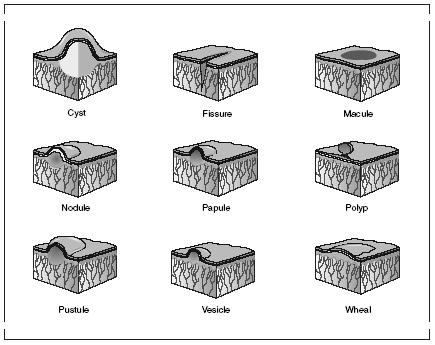
the body cannot shed old skin as rapidly as new cells are rising to the surface, raised patches of dead skin develop. These patches are seen on the arms, back, chest, elbows, legs, folds between the buttocks, and scalp.
The cause of psoriasis is unknown. In some cases, it may be hereditary or inherited. Attacks of psoriasis can be triggered by injury or infection, stress, hormonal changes, exposure to cold temperature, or steroids and other medications.
The treatment for psoriasis depends on its severity. Steroid creams and ointments are commonly used to treat mild or moderate psoriasis. If the case is more severe, these medications may be used in conjunction with ultraviolet light B (UVB) treatments. Strong medications are reserved for those individuals suffering from extreme cases of psoriasis.
Skin cancer
Skin cancer is the growth of abnormal skin cells capable of invading and destroying other cells. Skin cancer is the single most common type of cancer in humans. The cause of most skin cancers or carcinomas is unknown, but overexposure to ultraviolet radiation in sunlight is a risk factor.
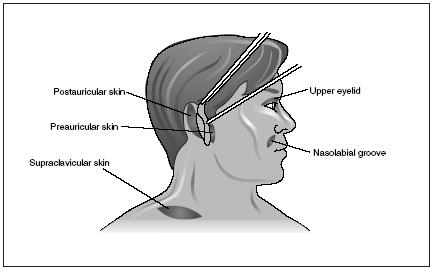
Basal cell carcinoma is the most common form of skin cancer, accounting for about 75 percent of cases. It is also the least malignant or cancerous (tending to grow and spread throughout the body). In this form of skin cancer, basal cells in the epidermis are altered so they no longer produce keratin. They also spread, invading the dermis and subcutaneous layer. Shiny, dome-shaped lesions develop most often on sunexposed areas of the face. The next most common areas affected are the ears, the backs of the hands, the shoulders, and the arms. When the lesion is removed surgically, 99 percent of patients recover fully.
Squamous cell carcinoma affects the cells of the second deepest layer of the epidermis. Like basal cell carcinoma, this type of skin cancer also involves skin exposed to the sun: face, ears, hands, and arms. The cancer presents itself as a small, scaling, raised bump on the skin with a crusting center. It grows rapidly and spreads to adjacent lymph nodes if not removed. If the lesion is caught early and removed surgically or through radiation, the patient has a good chance of recovering completely.
Malignant melanoma accounts for about 5 percent of all skin cancers, but it is the most serious type. It is a cancer of the melanocytes, cells in the lower epidermis that produce melanin. In their early stages, melanomas resemble moles. Soon, they appear as an expanding brown to black patch. In addition to invading surrounding tissues, the cancer spreads aggressively to other parts of the body, especially the lungs and liver. Overexposure to the Sun may be a cause of melanomas, but the greatest risk factor seems to be genetic. Early discovery of the melanoma is key to survival. The primary treatment for this skin cancer is the surgical removal of the tumor or diseased area of skin. When the melanoma has spread to other parts of the body, it is generally considered incurable.
Vitiligo
Vitiligo is a skin disorder in which the loss of melanocytes (cells that produce the color pigment melanin) results in patches of smooth, milky white skin. This often inherited disorder affects about 1 to 2 percent of the world's population. Although it is more easily observed in people with darker skin, it affects all races. It can begin at any age, but in 50 percent of the cases it starts before the age of twenty.
Medical researchers do not know the exact cause of the disorder. Some theorize that nerve endings in the skin may release a chemical that destroys melanocytes. Others believe that the melanocytes simply self-destruct. Still others think that vitiligo is a type of autoimmune disease, in which the body targets and destroys its own cells and tissues.
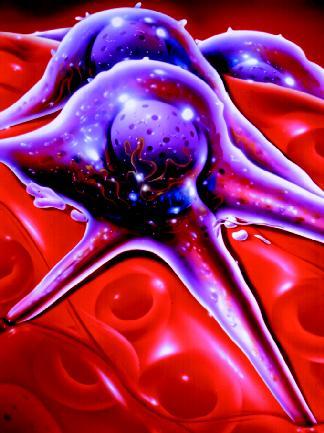
Vitiligo cannot be cured, but it can be managed. Cosmetics can be applied to blend the white areas with the surrounding normal skin. Sunscreens are useful to prevent the burning of affected areas and to prevent normal skin around the patches from becoming darker.
Warts
Warts are small growths caused by a viral infection of the skin or mucous membrane. The virus infects the surface layer. Warts are contagious. They can easily pass from person to person. They can also pass from one area of the body to another on the same person. Affecting about 7 to 10 percent of the population, warts are particularly common among children, young adults, and women. Common warts include hand warts, foot warts, and flat warts.
Hand warts grow around the nails, on the fingers, and on the backs of the hands. They appear mostly in areas where the skin is broken.
Foot warts (also called plantar warts) usually appear on the ball of the foot, the heel, or the flat part of the toes. Foot warts do not stick up above the surface like hand warts. If left untreated, they can grow in size and spread into clusters of several warts. If located on a pressure point of the foot, these warts can be painful.
Flat warts are smaller and smoother than other warts. They grow in great numbers and can erupt anywhere on the body. In children, they appear especially on the face.
Many nonprescription wart remedies are available that will remove simple warts from hands and fingers. Physicians use stronger chemical medications to treat warts that are larger or do not respond to over-the-counter treatments. Freezing warts with liquid nitrogen or burning them with an electric needle are advanced treatment methods.
Tattoos are relatively permanent marks or designs made on the skin. Tattoo comes from the Tahitian word tattau , meaning "to mark." The process of tattooing is accomplished by injecting colored pigment into small deep holes made in the skin. The modern method of tattooing employs an electric needle to inject the pigment.
People have been decorating their bodies with pictures of animals, flowers, supernatural creatures, and various designs for thousands of years. Egyptian mummies dating from 3035 B.C. have been discovered with ornate designs of flowers tattooed on their skin. Many ancient cultures believed that a tattoo of an animal could capture the mystical spirit of that animal and magically link the wearer to the animal depicted.
While many cultures have revered tattoos, many others have considered them vulgar and offensive. For as long as people have applied tattoos to their skin, they have sought ways to remove them.
In modern times, tattoos can be removed medically through one of four ways. If the tattoo is small, it can be surgically cut off and the skin sewn back together. In a method called dermabrasion, the tattoo is "sanded" with a rotary abrasive instrument until the layers of skin peel. Another method that uses abrasion is called salabrasion. In this procedure, which is centuries old, salt water is applied to the tattoo and then it is vigorously rubbed with some sort of sanding device until the tattoo pigments are dispersed. All three of these methods leave some sort of scarring, but the last method, laser surgery, does not. Pulses of light from a laser are directed onto the tattoo, breaking up its pigments. The pigments are then removed over the next few weeks by the body's defense cells.

Comment about this article, ask questions, or add new information about this topic: